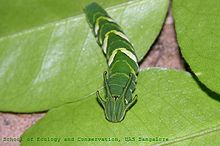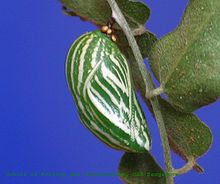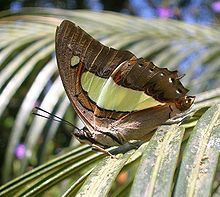- Polyura athamas
-
Common Nawab 
Polyura athamas attalus Dorsal side 
Polyura athamas attalus Ventral side Scientific classification Kingdom: Animalia Phylum: Arthropod Class: Insecta Order: Lepidoptera Family: Nymphalidae Tribe: Charaxini Genus: Polyura Species: P. athamas Binomial name Polyura athamas
(Drury) 1773Synonyms Polyura samatha Moore, [1879]
The Common Nawab (Polyura athamas) is a species of fast-flying canopy butterfly found in tropical Asia. It belongs to the Charaxinae (Rajahs and Nawabs) in the brush-footed butterfly family (Nymphalidae).
It occurs in the Himalayas from Kashmir to Sikkim, the hills of Central India and the Eastern Ghats, the Western Ghats and Southern India, Ceylon, Assam, Cachar, and via Myanmar and Tenasserim far into Indonesia.
Contents
Description
Male and female. Upperside black. Fore and hind wings with a discal broad transverse area from below vein 4 in fore wing to vein 2 on hind wing, a moderately large spot in interspace 5, a minute preapical dot beyond in interspace 6 on fore wing, and a subterrninal row of spots with two or three spots beyond them on the tornal angle of the hind wing, pale yellow, sometimes with an ochraceous, sometimes with a greenish tinge. The discal area on the fore wing nearly as broad in interspace 3 as on the dorsum, on the hind wing narrowing to an acute point on vein 2 at two-thirds of its length from base of wing. Tails touched with bluish grey. Underside with the discal transverse area and spot in interspace 5 as on the upperside; base and costal margin of the fore wing to apex, and base and dorsal margin of the hind wing broadly lilacine brown, on fore wing with two small black spots near base. Bordering the transverse discal area on the inner side, where it is margined with black lines, and above, is a broad chocolate carved band, continued more narrowly along the outer side of the discal area; beyond this on the fore wing is a concave series of dusky black lunules, on the hind wing the band itself is traversed by a line of obscure pale lunules ; finally on the hind wing there is a subterminal series of internally white-bordered black spots followed by an obscure ochraceous terminal line, and above the tornal angle a slender transverse black line from vein 1 to dorsal margin.[1]
Wingspan 64–85 mm.
Variation
"The species exhibits considerable seasonal variation, especially in South and North India ; for we find that the specimens obtained in March and April in North and North-west India have the discal band much widened and the underside pale, while the individuals flying in May and June have the band narrower, and those found in Sikkim from August to November have it narrowest. In South India there are two well distinguished forms, the one corresponding to the spring form of North India, but with the band less broad and representing most likely the dry-season brood, respectively a form that inhabits dry districts, and the second having the band narrower and the underside brighter in tint. In Burma broad-banded, pale specimens occur also, besides narrow-banded ones...... The differences exhibited by the pale and the narrow-banded forms have often been treated as being of specific value; for instance, the pale South Indian form has been described as E. agrarius, while the darker form is referred to as E. samatha; the North Indian spring form has been designated as E. hamasta, the form May to June as E. bharata, and the summer form as E. athamas.....As the species is so susceptible to climatical differences, it is self-evident that the individuals caught in the same month at the same locality, but in different years, are not always identical in the width of the band, and that, further, in different localities of the same country one may meet with somewhat different forms of athamas in one year, and identical forms in another year. This one must bear in mind in working with the individuals of athamas from a certain country"[2]
"Messrs. Rothschild and Jordan in their monograph of Charaxes and allied Prionopterous genera divide the forms of athamas occurring within our limits into two subspecies—(1) E. athamas athamas, the Northern and Eastern race, with three seasonal forms; and (2) E. athamas agrarius, the Southern Indian and Ceylon race, with two seasonal forms. The differences between the subspecies seem to not sufficient to necessitate detailed descriptions in the present work. Following Messrs. Rothschild and Jordan, I keep, with much doubt, however, the next form separate from athamas, of which it is possibly only a dimorph."[1]
Caterpillar
"Elongated, slug-shaped, dark green; head large, wide and surmounted by four divergent curved fleshy spinous processes; anal segment with two short naked terminal points ; the segments with an oblique yellowish-white lateral stripe, most prominent on the 7th, 9th and 11th segments, and beneath these a lower series of small white spots." (Moore.)[1]
Pupa
"Thick, cylindrically oval; green streaked with white; dorsum and thorax convex; head broad, truncated, obtusely pointed in front." (Moore.)[1]
Ecology
Eggs are laid on various species of Fabaceae plants. These include acacias such as A. caesia, A. catechu (Black Cutch) and A. farnesiana (Needle Bush), Adenanthera pavonina, Albizia species such as A. chinensis, A. corniculata, A. julibrissin (Nemu Tree) and A. lebbeck (Siris or lebbeck), Caesalpinia species such as C. bonduc, C. major and C. regia, Delonix regia (Gulmohar), Grewia spp., Leucaena leucocephala (White Popinac), Peltophorum pterocarpum (Copperpod), Pithecellobium clypearia and Pithecellobium dulce (Monkeypod).[3]
At least on Borneo but probably elsewhere too, adults do generally not visit carrion or old fruit to drink liquids.[4]
See also
- Anomalous Common Nawab (Polyura agraria)
Footnotes
- ^ a b c d Bingham (1905)
- ^ Rothschild and Jordan fide Bingham (1905).
- ^ Robinson et al. (2007)
- ^ Hamer et al. (2006)
References
- Bingham, C.T. (1905): The Fauna of British India, Including Ceylon and Burma. Lepidoptera, Volume 1
- Hamer, K.C.; Hill, J.K.; Benedick, S.; Mustaffa, N.; Chey, V.K. & Maryati, M. (2006): Diversity and ecology of carrion- and fruit-feeding butterflies in Bornean rain forest. Journal of Tropical Ecology 22: 25–33. doi:10.1017/S0266467405002750 (HTML abstract)
- Robinson, Gaden, S.; Ackery, Phillip R.; Kitching, Ian J.; Beccaloni, George W. & Hernández, Luis M. (2007): HOSTS - a Database of the World's Lepidopteran Hostplants. Accessed Accessed December 2006
Categories:- Polyura
- Fauna of Pakistan
- Butterflies of India
Wikimedia Foundation. 2010.




